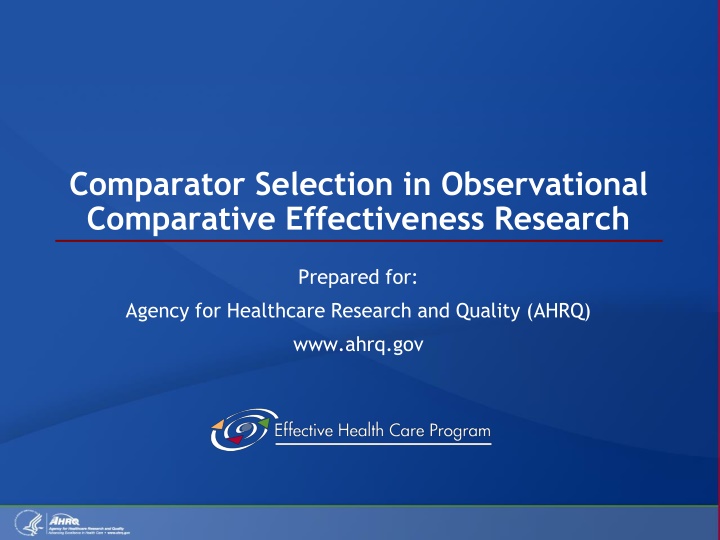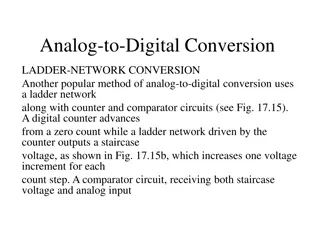Guide to Comparator Selection in Comparative Effectiveness Research
Proper selection of comparators is crucial in comparative effectiveness research to ensure the validity and clinical relevance of study results. This process involves choosing concurrent, active comparators from the same population, addressing potential biases, defining time zero for all comparator groups, and more. Factors such as confounding by indication or severity, exposure misclassification, and spectrum of possible comparisons must be carefully considered to enhance the internal validity of the study.
Download Presentation

Please find below an Image/Link to download the presentation.
The content on the website is provided AS IS for your information and personal use only. It may not be sold, licensed, or shared on other websites without obtaining consent from the author.If you encounter any issues during the download, it is possible that the publisher has removed the file from their server.
You are allowed to download the files provided on this website for personal or commercial use, subject to the condition that they are used lawfully. All files are the property of their respective owners.
The content on the website is provided AS IS for your information and personal use only. It may not be sold, licensed, or shared on other websites without obtaining consent from the author.
E N D
Presentation Transcript
Comparator Selection in Observational Comparative Effectiveness Research Prepared for: Agency for Healthcare Research and Quality (AHRQ) www.ahrq.gov
Outline of Material This presentation will: Show how to choose concurrent, active comparators from the same source population (or justify the use of no-treatment comparisons/ historical comparators/different data sources) Discuss potential bias (and methods to minimize it) associated with comparator choice Define time 0 for all comparator groups in describing planned analyses
Introduction In comparative effectiveness research, the choice of comparator directly affects the clinical implication, interpretation, and validity of study results. Treatment decisions are based on factors associated with underlying disease and its severity, general health status or frailty, quality of life, and patient preferences. There is potential for confounding by indication or severity and selection bias associated with different comparison groups. Internal validity relies on defining appropriate dose, intensity of treatment, and exposure window for comparator groups.
Consequences of Comparator Choice (1 of 2) Confounding arises when a risk factor for the study outcome of interest directly or indirectly affects exposure (e.g., treatment assignment). The magnitude of potential confounding is generally expected to be smaller when the comparator: Has the same indication Has similar contraindications Shares the same treatment modality (e.g., tablet or capsule) Conduct sensitivity analyses to quantify effects of potential unmeasured confounding.
Consequences of Comparator Choice (2 of 2) Exposure misclassification: Arises when exposure measurement differs between the exposure and comparator groups Is often more complex in comparative effectiveness research, since each group represents active treatment (nonuse of exposure treatment does not imply use of the comparator treatment) Can differ in each group, especially if different treatment modalities are used Assess separately for exposure versus comparison groups
Spectrum of Possible Comparisons (1 of 3) Alternative treatments Most common scenario and typically least biased More clinically meaningful and methodologically valid Could still result in confounding by severity if not adequately controlled through design/analysis No treatment/testing Absence of exposure or absence of exposure and use of an unrelated treatment (active comparator) Choice of time 0 must be clinically appropriate in order to reduce bias
Spectrum of Possible Comparisons (2 of 3) Usual or standard care Develop a valid operational definition for care and for time at initiation (none, single, or a set of treatment/testing modalities) Real-world use must be understood for proper definition Can vary across geographic regions/treatment settings or change over time; avoid a wastebasket definition Historical comparison Used with a dramatic shift from one treatment to another May be the only choice with strong selection for a new treatment that is uncontrollable and randomization is unethical/not realistic Vulnerable to confounding by indication/severity when this information is unmeasured (overcome by instrumental variable analysis using calendar time)
Spectrum of Possible Comparisons (3 of 3) Comparison groups from different data sources Multiple data sources can be linked to enhance the validity of observational comparative effectiveness studies Residual confounding might occur due to: Incomparability of information in exposure and comparison groups Differences in observed and unobserved domains as they are sampled differently or different source populations Issues with generalizability when exposure and comparison groups come from different databases
Operationalizing the Comparison Group in Comparative Effectiveness Research (1 of 2) Indication Another treatment used for the same indication as the exposure treatment typically is used as the comparison group Treatments approved for multiple indications appropriate indication will have to be ensured by defining the indication and restricting the study population Initiation New-user design prevents underascertainment of early events and avoids selection bias arising from prevalent users Inclusion of prevalent users may be justified when outcomes are rare or occur after long periods of use
Operationalizing the Comparison Group in Comparative Effectiveness Research (2 of 2) Exposure time window Period where therapeutic benefit and/or risk would plausibly occur Sensitivity analysis to assess whether results are sensitive to different specifications of the exposure window(s) Nonadherence May differ between treatment and comparators Treatment effects should be compared at adherence levels observed in clinical practice, rather than adjusting for the difference in adherence Dose/intensity of drug comparison Assess and report dose in each group Make comparisons at clinically equivalent dose levels
Considerations for Comparisons Across Different Treatment Modalities (1 of 3) Confounding by indication or severity: Medications may be used for patients with a milder disease, and surgery might be reserved for those with more severe disease. Selection of healthier patients to receive more invasive treatments: Sicker patients are less likely to be considered for invasive procedures. Selection becomes more problematic in comparisons across different treatment modalities.
Considerations for Comparisons Across Different Treatment Modalities (2 of 3) Time from disease onset to a treatment: Pay careful attention to the time from initial diagnosis and the general sequence of different treatment modalities needed to prevent immortal person-time bias. Different magnitude of misclassification in drug exposure versus procedure comparison: Misclassification of exposure might be greater with drugs than with devices/procedures. Pharmacy records do not provide information on actual intake.
Considerations for Comparisons Across Different Treatment Modalities (3 of 3) Provider effects in using devices or surgeries: Consider the characteristics of the operating physician and institution where the device implantation or surgery was carried out Be aware of the documented direct relationship between the level of physician experience and better patient outcomes for complex procedures Adherence to drugs and device failure or removal: Requires assumptions in most data sources May be appropriate to compare without adjusting, as it reflects real-world use
Conclusions Understanding the impact of comparator choice on study design is important. Selection of the comparator group should be primarily driven by a comparative effectiveness question prioritized by the stakeholder community. An over-riding consideration is the generation of evidence that should directly inform decisions on treatments, testing, or health care delivery systems. Some study questions may not be answered validly due to intractable bias in observational comparative effectiveness research.
Summary Checklist Guidance Key Considerations Choose concurrent, active comparators from the same source population (or justify use of no-treatment comparisons/historical comparators/different data sources) Comparator choice should be primarily driven by a comparative effectiveness question prioritized by the informational needs of the stakeholder community and secondarily as a strategy to minimize bias Discuss potential bias associated with comparator choice and methods to minimize such bias, when possible Be sure to also describe how study design/analytic methods will be used to minimize bias Define time 0 for all comparator groups in describing planned analyses Choice of time 0, particularly in no-treatment or usual care, should be carefully considered in light of potential immortal time bias and prevalent user bias Employ a new-user design as a default, if possible























